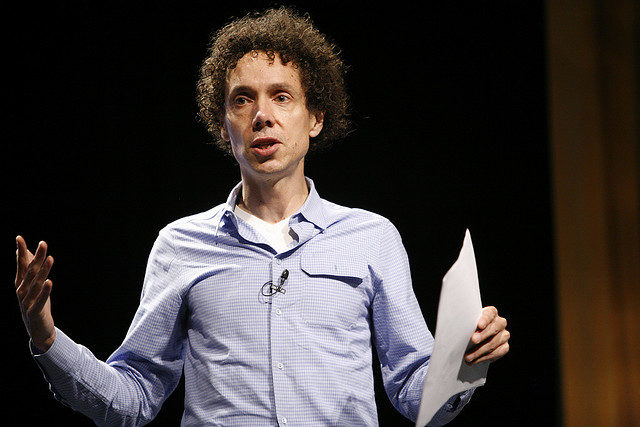Malcolm Gladwell on the hunt for cool
“The Coolhunt” explores the strange science behind the search for fashion trends at street level.
Malcolm Gladwell, “The Coolhunt,” The New Yorker, March 17, 1997
By Sara Hawary
“The Coolhunt” investigates the process of looking for new fashion trends at street level and determining how to apply them to the design and marketing of a company’s next clothing line. It primarily follows DeeDee Gordon and Baysie Wightman, two skilled “coolhunters,” and distinguishes the different methods each of them implements and how they work in affecting the end product. Gladwell, the Canadian journalist and author, has been a New Yorker staff writer since 1996. He has also written five best-selling books, including David and Goliath: Underdogs, Misfits and the Art of Battling Giants (2013), What the Dog Saw: And Other Adventures (2009), Outliers: The Story of Success (2008), Blink: The Power of Thinking Without Thinking (2005) and The Tipping Point: How Little Things Can Make a Big Difference (2000).
Gladwell coins the term “coolhunting” to refer to the jobs of Baysie, who is a merchandise manager at Reebok, and DeeDee, who works at Lamesis, an advertising agency. The piece describes the different approaches of coolhunting and induces the reader to gradually understand what the term really entails, with examples from varying scenarios. The reader becomes aware that the idea of “cool” is not as simple as it seems. Something deemed cool is made into a phenomenon through an intricate set of steps that take a certain level of skill to fully grasp. He introduces the three “rules of cool” and emphasizes their interconnectedness. He turns the reader’s view of coolhunting from a concept as simple as finding the newest trends among youth in the city, to a scientific formula or “paradox” almost reminiscent of Newton’s laws of motion. This unlikely methodology grabs the reader’s attention and portrays the significance of the topic.
In focusing on DeeDee and Baysie, Gladwell describes how they look, talk and dress. He wants the reader to identify with them and get to know them as individuals. One of the “rules of cool” is that you have to “be one to know one”—a coolhunter must be cool herself. She has to have a developed instinct for cool, to be able to detect and isolate it in the crowd of cool-kid candidates. Gladwell provides detailed, raw descriptions of anything that could be classified as “cool.” In scenes where Baysie is questioning kids at Dr. Jay’s, he quotes their responses word-for-word, making sure that every aspect of these cool kids is portrayed clearly, including their use of slang and not-so-correct grammar. The fact that the one kid says “get butter” instead of “get better” is a factor in Baysie deciding that he’s the perfect target, and “so fucking smart.” Gladwell highlights what makes these kids “innovators” for Baysie and DeeDee.
Another part of the formula to determine how a trend becomes cool is “diffusion research,” or going through the steps of a trend’s initial adoption to its integration in the mainstream culture. The innovators are the first group in the process, Gladwell takes us through a 1930s study about early farmers and the adoption of hybrid seed corn. The innovator farmers are followed by the “early adopters,” then the “early majority” and, finally, the “late majority.” The study depicts the gradually rising number of farmers planting the hybrid seed corn through time, based on the exposure each group has on the next group. Although Gladwell’s original topic has nothing to do with farming, using this as an analogy helps the reader understand how the type of research that goes with coolhunting was present long before Baysie and DeeDee, and conducted by many different industries.
Gladwell points out that by reading this article the reader does not automatically become cool herself. Even the writer, who conducted this detailed study and spoke to various coolhunters about what’s cool and what isn’t, admits that he “of course, [doesn’t] get it. [He] can’t get it.” The reader might be forgiven for thinking that Gladwell indeed “gets it,” as he has illustrated the phenomenon pretty well. But that simply makes clearer the purpose of the story—not to teach you how to spot cool yourself, but to understand how “cool” is determined. The reader may want to venture back to the opening sentence, which might have seemed vague and cryptic at first—“Who decides what’s cool? Certain kids in certain places—and only coolhunters know who they are”—and realize exactly what was meant by it, as it reflects directly what the “rules of cool” are all about.
[[{“fid”:”3715″,”view_mode”:”default”,”fields”:{“format”:”default”,”field_file_image_alt_text[und][0][value]”:””,”field_file_image_title_text[und][0][value]”:””},”type”:”media”,”link_text”:null,”attributes”:{“height”:”615″,”width”:”489″,”style”:”width: 75px; height: 101px; margin-left: 10px; margin-right: 10px; float: left;”,”class”:”media-element file-default”}}]]Sara Hawary is a graduate of Ryerson University’s Graphic Communications Management program.
Students and non-students alike may write a Great Canadian Literary Journalism story on a worthy piece of literary journalism/long form/feature writing/reportage. If interested, please contact Bill Reynolds, reynolds@ryerson.ca.
Lead photo by Pop!Tech, via Flickr.

